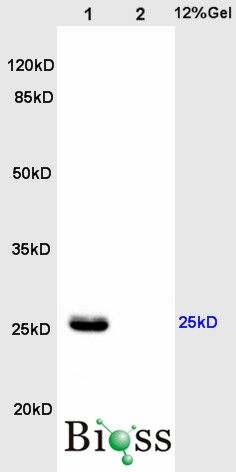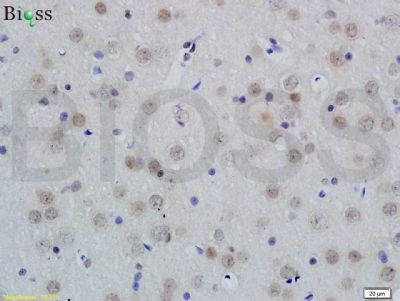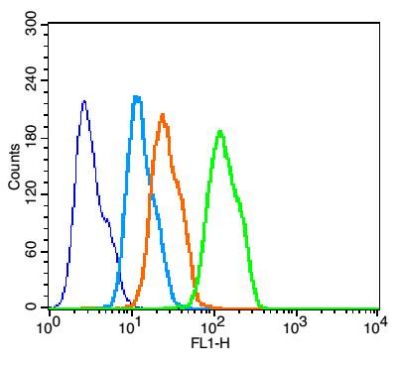产品中心
当前位置:首页>产品中心Anti-BDNF
货号: bs-0248R 基本售价: 380.0 元 规格: 20ul
- 规格:20ul
- 价格:380.00元
- 规格:50ul
- 价格:780.00元
- 规格:100ul
- 价格:1380.00元
- 规格:200ul
- 价格:2200.00元
产品信息
- 产品编号
- bs-0248R
- 英文名称
- BDNF
- 中文名称
- 脑源神经营养因子抗体
- 别 名
- Abrineurin; Brain Derived Neurotrophic Factor; MGC34632; Neurotrophin; BDNF_HUMAN.
- 规格价格
- 50ul/780元购买 100ul/1380元购买 200ul/2200元购买 大包装/询价
- 说 明 书
- 50ul 100ul 200ul
- 研究领域
- 神经生物学 信号转导 生长因子和激素 转录调节因子 激酶和磷酸酶
- 抗体来源
- Rabbit
- 克隆类型
- Polyclonal
- 交叉反应
- Human, Mouse, Rat, Dog, Pig, Cow, Horse, Rabbit, Guinea Pig,
- 产品应用
- WB=1:500-2000 ELISA=1:500-1000 IHC-P=1:400-800 IHC-F=1:400-800 Flow-Cyt=1μg /test IF=1:100-500 (石蜡切片需做抗原修复)
not yet tested in other applications.
optimal dilutions/concentrations should be determined by the end user.
- 分 子 量
- 13/27kDa
- 细胞定位
- 细胞核 分泌型蛋白
- 性 状
- Lyophilized or Liquid
- 浓 度
- 1mg/ml
- 免 疫 原
- KLH conjugated synthetic peptide derived from human BDNF:81-180/247
- 亚 型
- IgG
- 纯化方法
- affinity purified by Protein A
- 储 存 液
- 0.01M TBS(pH7.4) with 1% BSA, 0.03% Proclin300 and 50% Glycerol.
- 保存条件
- Store at -20 °C for one year. Avoid repeated freeze/thaw cycles. The lyophilized antibody is stable at room temperature for at least one month and for greater than a year when kept at -20°C. When reconstituted in sterile pH 7.4 0.01M PBS or diluent of antibody the antibody is stable for at least two weeks at 2-4 °C.
- PubMed
- PubMed
- 产品介绍
- background:
Neurotrophins function to regulate naturally occurring cell death of neurons during development. The prototype neurotrophin is nerve growth factor (NGF), originally discovered in the 1950s as a soluble peptide promoting the survival of, and neurite outgrowth from, sympathetic ganglia. More recently, three additional structurally homologous neurotrophic factors have been identified. These include brain-derived neurotrophic factor (BDNF), neurotrophin-3 (NT-3) and neurotrophin-4 (NT-4), also designated NT-5. These various neurotrophins stimulate the in vitro survival of distinct but partially overlapping populations of neurons. The Trk A receptor is the preferential receptor for NGF, but also binds NT-3 and NT-4. The Trk B receptor binds equally well to both BDNF and NT-4 and to a lesser extent NT-3, while the Trk C receptor only binds NT-3. BDNF promotes the survival of neuronal populations that are all located either in the central nervous system or directly connected to it. Belongs to the NGF-beta family.
Function:
During development, promotes the survival and differentiation of selected neuronal populations of the peripheral and central nervous systems. Participates in axonal growth, pathfinding and in the modulation of dendritic growth and morphology. Major regulator of synaptic transmission and plasticity at adult synapses in many regions of the CNS. The versatility of BDNF is emphasized by its contribution to a range of adaptive neuronal responses including long-term potentiation (LTP), long-term depression (LTD), certain forms of short-term synaptic plasticity, as well as homeostatic regulation of intrinsic neuronal excitability.
Subunit:
Monomers and homodimers. Binds to NTRK2/TRKB.
Subcellular Location:
Secreted.
Tissue Specificity:
Brain. Highly expressed in hippocampus, amygdala, cerebral cortex and cerebellum. Also expressed in heart, lung, skeletal muscle, testis, prostate and placenta.
Post-translational modifications:
The propeptide is N-glycosylated and glycosulfated.
Converted into mature BDNF by plasmin (PLG).
DISEASE:
Defects in BDNF are a cause of congenital central hypoventilation syndrome (CCHS) [MIM:209880]; also known as congenital failure of autonomic control or Ondine curse. CCHS is a rare disorder characterized by abnormal control of respiration in the absence of neuromuscular or lung disease, or an identifiable brain stem lesion. A deficiency in autonomic control of respiration results in inadequate or negligible ventilatory and arousal responses to hypercapnia and hypoxemia. CCHS is frequently complicated with neurocristopathies such as Hirschsprung disease that occurs in about 16% of CCHS cases.
Similarity:
Belongs to the NGF-beta family.
SWISS:
P23560
Gene ID:
627
Database links:Entrez Gene: 627 Human
Entrez Gene: 12064 Mouse
Entrez Gene: 24225 Rat
Omim: 113505 Human
SwissProt: P23560 Human
SwissProt: P21237 Mouse
SwissProt: P23363 Rat
Unigene: 502182 Human
Unigene: 1442 Mouse
Unigene: 11266 Rat
Important Note:
This product as supplied is intended for research use only, not for use in human, therapeutic or diagnostic applications.
神经生物学相关蛋白(Neurobiology)
人脑源性神经营养因子(BDNF)和神经营养素-3(NT-3)神经生长因子(NGF)属于神经营养因子(NTF)家族的组成成员,具有促进早期神经元的增殖与分化,维持成熟神经元的存活的生物学功能,能调控神经元再生的微环境、可促进运动神经元的存活和生长并能防止它受损及死亡。对治疗神经系统疾病有广泛的临床应用前景。
目前已经用于某些疾病的临床试验:如早期老年性痴呆症、帕金森氏症、糖尿病、艾滋病或其他原因引起的外周神经损伤等研究。
- 产品图片
 Sample:
Sample:
Brain(Rat)lysate at 30ug;
Heart(Rat)lysates, 30ug
Primary: Anti-BDNF (bs-0248R) at 1:200
Secondary: HRP conjugated Goat-Anti-Rabbit IgG(bse-0295G) at 1: 3000
Predicted band size : 13kD,25kD
Observed band size : 25kD Tissue/cell: rabbit brain tissue; 4% Paraformaldehyde-fixed and paraffin-embedded;
Tissue/cell: rabbit brain tissue; 4% Paraformaldehyde-fixed and paraffin-embedded;
Antigen retrieval: citrate buffer ( 0.01M, pH 6.0 ), Boiling bathing for 15min; Block endogenous peroxidase by 3% Hydrogen peroxide for 30min; Blocking buffer (normal goat serum,C-0005) at 37℃ for 20 min;
Incubation: Anti-BDNF Polyclonal Antibody, Unconjugated(bs-0248R) 1:200, overnight at 4°C, followed by conjugation to the secondary antibody(SP-0023) and DAB(C-0010) staining Tissue/cell: rat brain tissue; 4% Paraformaldehyde-fixed and paraffin-embedded;
Tissue/cell: rat brain tissue; 4% Paraformaldehyde-fixed and paraffin-embedded;
Antigen retrieval: citrate buffer ( 0.01M, pH 6.0 ), Boiling bathing for 15min; Block endogenous peroxidase by 3% Hydrogen peroxide for 30min; Blocking buffer (normal goat serum,C-0005) at 37℃ for 20 min;
Incubation: Anti-BDNF Polyclonal Antibody, Unconjugated(bs-0248R) 1:200, overnight at 4°C, followed by conjugation to the secondary antibody(SP-0023) and DAB(C-0010) staining Blank control: HepG2(blue).
Blank control: HepG2(blue).
Primary Antibody:Rabbit Anti-BDNF antibody (bs-0248R,Green); Dilution: 1μg in 100 μL 1X PBS containing 0.5% BSA;
Isotype Control Antibody: Rabbit IgG(orange) ,used under the same conditions;
Secondary Antibody: Goat anti-rabbit IgG-FITC(white blue), Dilution: 1:200 in 1 X PBS containing 0.5% BSA.
Protocol
The cells were fixed with 2% paraformaldehyde for 10 min at 37℃. Primary antibody (bs-0248R, 1μg /1x10^6 cells) were incubated for 30 min at room temperature, followed by 1 X PBS containing 0.5% BSA + 1 0% goat serum (15 min) to block non-specific protein-protein interactions. Then the Goat Anti-rabbit IgG/FITC antibody was added into the blocking buffer mentioned above to react with the primary antibody at 1/200 dilution for 40 min at room temperature. Acquisition of 20,000 events was performed.

